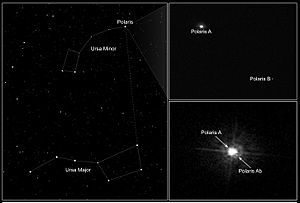Polaris (star) facts for kids

Polaris is also known as the North Star or Pole Star. It is the brightest star in the constellation called Ursa Minor, which means "Little Bear".
Polaris is special because it appears almost directly above Earth's North Pole. This makes it look like it stays in the same spot in the sky all night long. For a very long time, sailors in the northern hemisphere used Polaris to find their way. It helped them know where they were on the ocean and in which direction they were traveling.
Contents
What Kind of Star System is Polaris?
Polaris is not just one star; it is a triple star system. This means it is made up of three stars that are gravitationally bound together.
Polaris A: The Main Star
The main star is called Polaris A. It is a giant star, much bigger than our Sun. Polaris A has about 4.5 times the mass of the Sun. Its diameter is about 45 million kilometers.
Polaris A is also a special type of star called a Cepheid variable. This means its brightness changes regularly over time. It is the closest Cepheid variable star to Earth in the whole Milky Way galaxy.
Polaris B and Ab: Its Companions
Polaris has two companion stars. One is called Polaris B. It orbits Polaris A quite far away, about 2,400 AU from it. (One AU is the distance from Earth to the Sun). You can even see Polaris B with a small telescope.
The other companion is a tiny dwarf star called Polaris Ab. It orbits very close to Polaris A. This dwarf star was predicted to exist in 1929. However, scientists only saw it recently. Polaris Ab orbits Polaris A at a distance similar to how far Uranus is from our Sun.
Why Polaris is the North Star (For Now)
Even though Polaris is the North Star today, it has not always been. The direction that Earth's North Pole points in the sky changes very slowly over thousands of years. This slow wobble is called stellar precession.
For example, about 5,000 years ago (around 3000 BC), a faint star named Thuban was the North Star. Thuban is in the constellation of Draco. Polaris only became the North Star around AD 500.
Polaris will get even closer to being directly above Earth's North Pole. This will happen around the year 2102. After that, it will slowly start to move away again. Polaris will remain the closest star to the pole until about AD 3000.
How Far Away is Polaris?
Scientists are still working to figure out the exact distance to Polaris. Many recent studies suggest Polaris is about 434 light-years away from Earth. (A light-year is the distance light travels in one year). This is equal to about 133 parsecs.
However, some scientists believe it might be as much as 30% closer. Knowing the exact distance to Polaris is very important. This is because Polaris is the closest Cepheid variable star. Studying it helps astronomers measure distances to other objects in space. It is a key part of the "cosmic distance ladder".
No South Pole Star
It might surprise you, but there is no bright star like Polaris in the southern sky. This means sailors in the southern hemisphere cannot use a single bright star to find their way. They rely on other methods, like using groups of stars or instruments.
Images for kids
-
Big Dipper and Ursa Minor in relation to Polaris
See also
 In Spanish: Polaris (estrella) para niños
In Spanish: Polaris (estrella) para niños








